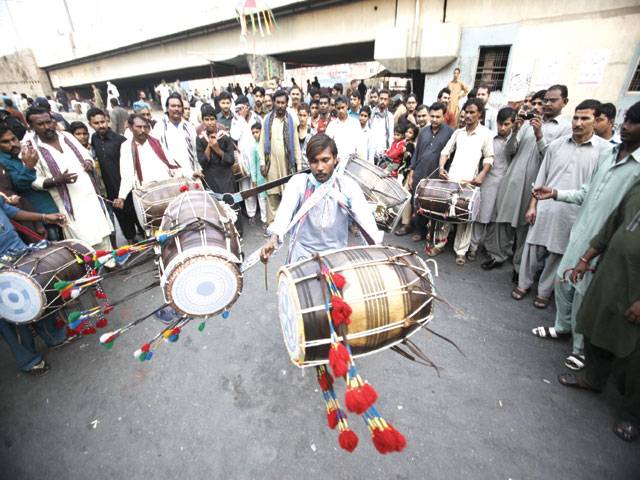LAHORE - A resident of Shakoorabad village in Okara district, 150 kilometres west of Lahore, Muhammad Mushtaq sits with a troupe of drummers at Thokar Niaz Baig Chowk every day in search of livelihood.
Drumbeating holds no charm for him though people invite his group to double up their festivities at marriages and rituals across the city. He says survival in this field is now difficult.
“Our children are not much interested in this work,” he complained while sitting beside his brother and fellow beaters. They were all waiting for the customers. He said his other three brothers do the same job in their native area.
Dhol or drum is the most popular musical instrument of Punjab and considered similar to western drum, classical Hindustani tabla, Cuban conga which is also known as tumbadora and Egypt, middle east and north Africa’s darbukah which is also called goblet. A Dhol master can play more than a dozen beats (taals) but majority of the performers stuck to four or five. Mushtaq and his fellows learnt taals of bhangra, disco, thaika, dhamal, jhummar and luddi.
Drummers in Lahore believe the best among them mostly belong to Jhang, Pakpattan and Okara though the art is not bound to areas.
A good drummer could perform without break for three to four hours but they say ‘it depends upon circumstance, environment and most of the time on currency notes showering.’
Normally two drum beaters receive Rs600 to Rs800 in advance to perform on a festivity in addition to the currency notes showered on them during the performance. Mushtaq said sometime they earn Rs2,000 to Rs4,000 in a trip and the day would be a blessing for them. But, he said, most of the days they sit idle, waiting for customers.
Sitting in almost every known chowk and areas of the city, they mostly wear yellow clothes—yellow which symbolises sanctity. The colour is part of Indo-Pak wedding festivities and rituals for centuries.
In most of Punjab areas, the drum beating is an art which transmitted not through any training centre but from generation to generation. From the father to offspring, it automatically trickles down due to lifestyle and association of the kids with this cultural activity from the early age.
Mushtaq is in late 40s and he learned the art from his father who was trained by his grandfather. He shifted to Lahore some 20 years ago when according to him ‘there was enough work and enough money.’
Punjab Institute of Language, Arts and Culture (PILAC) Director Dr Sughra Safad said that this artifice has been fashion in the Punjab rural life for centuries.
“If we going through the Sufi poetry we also find deep vivid touches of these drumbeaters who were recognise as central party of any festivity and ritual.” A National College of Arts professor seeking anonymity expressed regret that the pure form of the art was diminishing and the government so far failed to take any step towards its patronization. The situation is, he said, quite different in India’s Punjab where multiple programmes were launched by the government to protect rich culture of Punjab.
“The situation has become worse at present after it saw its climax some thirty years ago when these drummers and dancers used to enthral the participants in weddings, mehdi, melas and others festivals in urban and rural Punjab,” said the professor.
Mustaq was sitting with Iqbal, Sarwar and Irshad in a busy chowk. They are the artists who belong to humble and poor background and are living miserable condition due to many factors. The principal factors are speedy radicalisation and digitalisation of the society.






